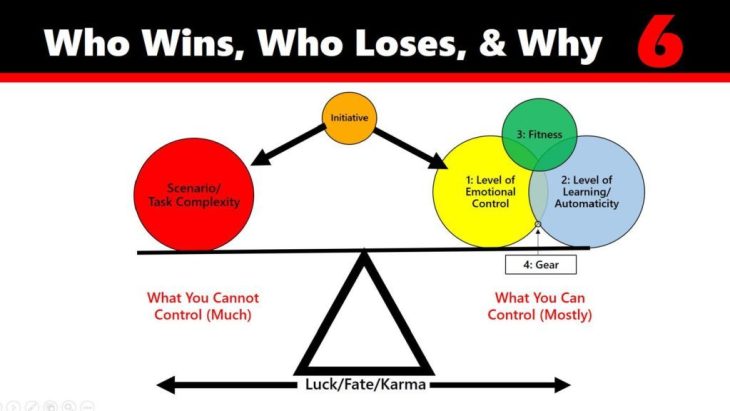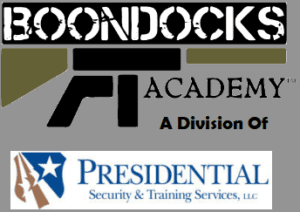Automaticity
Automaticity – au·to·ma·tic·i·ty – the ability to do things without occupying the mind with the low-level details required, allowing it to become an automatic response pattern or habit. It is usually the result of learning, repetition, and practice.
Recently I have been reading a book by Karl Rehn and John Daub entitled, “Strategies and Standards for Defensive Handgun Training.” In the book, I came across the graphic below. It is also found in “Straight Talk on Armed Defense” which is a collaboration of content from well known instructors and edited by Massad Ayoob. The diagram indicates the most important factors necessary to prevailing in a gunfight. As you can tell from the diagram, the most important factors are the ability to control your emotions and your level of automaticity. The other two factors on the “What You Can Control Side” are Fitness and Gear, with gear being the smallest factor. Another interesting fact in Karl and John’s book is the very low percentage of gun owners that train on a regular basis. He estimates that only about 1% of gun owners who have taken a Basic Permit class ever go on to take a more advanced class or shoot in a match. Instead, gun owners are spending their resources on purchasing new guns. According to the FBI NICS data, the number of background checks for gun purchases have tripled from 8 million in 2000 to over 26 million last year. The actual number of gun purchases is likely much higher since the 17 million Permit Holders in the United States would not have to go through a NICS background check when purchasing a gun. So, it appears as if gun owners and permit holders are investing their money in gear instead of training, the exact opposite of what the graphs suggests. Now, don’t get me wrong, I like buying new guns as much as anyone, but buying new guns and not actually training with them is probably the worst-case scenario for those serious about carrying a firearm for personal defense.

Beware of the man that only owns one gun, he probably knows how to use it. The only way to build automaticity with a particular gun is to train/practice with THAT gun. If you’re buying new and different guns on a regular basis then you are probably not going to be able to increase your automaticity with any one gun. If you have to rely on your brain to remember that the gun you are carrying today has a safety, or that you need to chamber a round before you fire, you’re already behind the “emotional control” curve. During a gunfight, your body should be able to automatically draw and fire without ever having to “think” about it. That is automaticity, and when you have reached that level in your training, then your brain is free to focus on emotional control.
Gaining Emotional Control
Once you have gained automaticity, the next step is to work on emotional control. One of the best ways to do that is through experience. In an article called Training vs. Experience, Greg Ellifritz with Active Response Training talks about some of the best ways to gain experience. He also highlights an FBI study that talks about the experience level of your potential attacker. The results of the study are staggering
- “Nearly 40% of the criminal attackers in this study had received FORMAL firearms training”
- “More than 80% of the criminal attackers regularly practiced with their firearms, with an average number of 23 Practice Sessions Per Year!”
- “More than 40% of the criminals identified in the study had at least one gunfight experience before attacking the officer”
- “25% of the attackers had been involved in more than five gunfights!”
One felon in the study had been shot in 10 different gunfights, before being killed by a homeowner during a home invasion. Do you think he had more experience and emotional control than the average gun owner? Greg does a great job in his article giving you some options to help you gain experience, which includes force-on-force training. Greg states “the best type of this training is conducted at professional shooting schools and uses tightly-scripted professional role players. It is costly, but worth the expense. You will learn more in one day of this type of training than you will learn in weeks of practicing by yourself.”
To Test Your Equipment, You Have to Stress Your Equipment
While the gear you use in a gunfight is not as important as your emotional control and automaticity, it does need to work. Simply taking your gun to a range and punching holes in paper a couple of times a year is not truly testing your gear. In order to be confident your gear will work when you need it to, you need to be stress testing that gear. That means drawing and shooting under some type of stress like a timed course of fire, shooting from retention or compromised positions. These types of drills can’t be covered in a one-day Basic Permit class, your going to have to look into at least a 2-day class where you are putting hundreds of rounds down range in a variety of drills. I can’t tell you how many times we have seen sub-par gear or heavily modified guns fail during these types of training classes or during a shooting match. In fact, almost every single nationally known trainer will tell you to bring a SPARE GUN to their class.
Are You Fit Enough?
One of the final aspects of “What You Can Control” is fitness. While fitness is definitely important in being able to survive a gunfight, it may be more important in a whole host of situations. Our friend, Dave Spaulding, does an excellent job in this video on the importance of fitness and being able to be an active participant in your own rescue. I encourage you to take a few minutes to watch it.
The bottom line is to “invest in yourself.” You will likely fair much better both physically and financially if you spend your resources on training, rather than chasing the latest, greatest gun or gadget to try and improve your shooting. Believe it or not, the money spent on training will likely guide you to the best gun for you long before you find it on your own.

